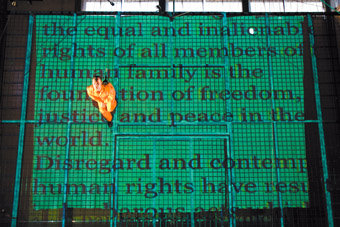Editorial, issue #74 Aug-Sept 2006

Brendan Shelper, Honour Bound
photo Adam Craven
Brendan Shelper, Honour Bound
The abandonment of David Hicks & social democracy
As we go to print Nigel Jamieson’s Honour Bound is premiering at the Sydney Opera House as part of its innovative Adventures in the Dark program. The quest for national security as part of the ‘war on terror’ has become an excuse for a radical reduction in human rights by governments around the world, most blatantly in the case of the US incarceration of David Hicks. Consequently, Hicks has become a living symbol of what could happen to any citizen given the draconian nature of Australia’s anti-terror legislation, and that includes the special place it holds for journalists, cartoonists and artists, all less than assured by John Howards’ ‘Trust me.’ Australian artists of many kinds and in many media have kept their audiences alert to the issues pertaining to refugees, political spin and the escalating erosion of social democracy. Filmmaker Curtis Levy’s documentary The President versus David Hicks has been widely seen. Now writer-director-designer Nigel Jamieson, with ADT’s Garry Stewart, sound designer Paul Charlier, video artist Scott Otto Anderson and co-designer Nick Dare, brings a mutimedia performance perspective to one man’s plight and the ramifications for social democracy.
ARTIST [AS] EDUCATOR
Our 2006 Education and the Arts feature is revealing about the advantages and the tensions embodied in the dual roles of artist and teacher in tertiary arts education. Some of the artist-teachers interviewed by our writers see themselves as artists first who enjoy teaching and the benefits it brings (contact with students, academic networks, salaries, paid research). Others who started out as artists have become full-time teachers but have managed to take time out to pursue artistic projects to regain a sense of wholeness and authenticity. Most don’t see the artist and teacher roles as exclusive, after all some make art within the university with student and staff collaborators and they find their practice-led research deeply satisfying—that’s if they can secure it and if not swamped by increasing bureaucratic responsibilities. There is also a feeling that in institutions and departments that are producing the practising artists of the future it is vital that students have at least some contact with artist-teachers who work beyond the university. Teachers in dance and film, in particular, emphasise their up to date knowledge of the field and the contacts they can provide students.
A recurrent theme in our survey is the importance of research, respondents feeling that it’s where they can sustain their practice while teaching and fulfil their obligations as academics. Not surprisingly the balancing act metaphor frequently comes into play, but it’s not just between being an artist and a teacher, but a 3-way creative tension between artist, teacher and researcher. The pressure is on universities and government to recognise artistic practice as research and not just in postgraduate degrees but as part of the teachers’ ongoing academic life. Another interesting dimension to this issue was raised in the articles on the artist-teacher in new media art and film. Pat Laughren observed that film schools have increasingly become the home for sustained practice of documentary film making. Despite proliferating, as many articles in this edition attest, new media art is going through a hard time on a number of fronts. While artist-teachers have played a key role in its development, Christy Dena sees the university more than ever as a vital home for the field.
Unleashing art as research: SPIN
In 2005 our education feature, Postgrad [R]evolution, focused on creative doctorates and practice-led research degrees, revealing the challenges to traditional academic notions of research, problems of assessment and resources, but also the joy of having one’s work recognised for the knowledge it provides the world. In this edition, QUT’s Richard Vella announces the launch of SPIN (Speculation and Innovation: Applying practice led research in the Creative Industries) in collaboration with RealTime (p10). SPIN is an online, peer-reviewed journal that includes papers and artworks and is aimed at giving a public profile and much deserved credibility to artists whose research will develop their own and inform the practice of others globally.
–
RealTime issue #74 Aug-Sept 2006






